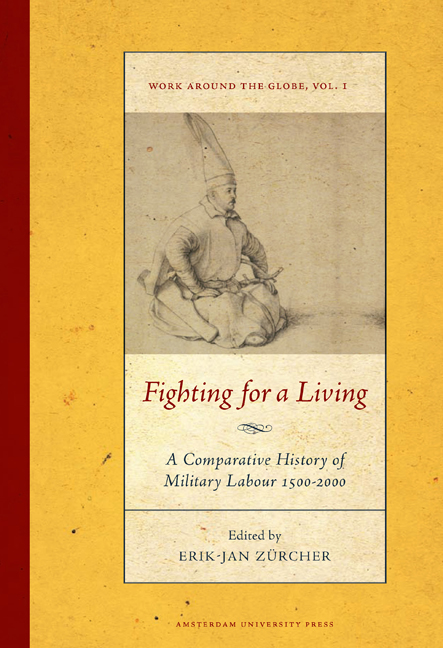Book contents
- Frontmatter
- Dedication
- Contents
- Preface
- Introduction: Understanding Changes in Military Recruitment and Employment Worldwide
- Military Labor in China, c. 1500
- From the Mamluks to the Mansabdars: A Social History of Military Service in South Asia, c. 1500 to c. 1650
- On the Ottoman Janissaries (Fourteenth-nineteenth Centuries)
- Soldiers in Western Europe, c. 1500-17901
- The Scottish Mercenary as a Migrant Labourer in Europe, 1550-1650
- Change and Continuity in Mercenary Armies: Central Europe, 1650-1750
- Peasants Fighting for a Living in Early Modern North India
- “True to Their Salt”: Mechanisms for Recruiting and Managing Military Labour in the Army of the East India Company During the Carnatic Wars in India
- “The Scum of Every County, the Refuse of Mankind”: Recruiting the British Army in the Eighteenth Century
- Mobilization of Warrior Populations in the Ottoman Context, 1750-1850
- Military Employment in Qing Dynasty China
- Military Service and the Russian Social Order, 1649-1861
- The French army, 1789-1914: Volunteers, Pressed Soldiers, and Conscripts
- The Dutch Army in Transition: From All-volunteer Force to Cadre-militia Army, 1795-1830
- The Draft and Draftees in Italy, 1861-1914
- Nation-building, War Experiences, and European Models: The Rejection of Conscription in Britain
- Mobilizing Military Labor in the Age of Total War: Ottoman Conscription Before and During the Great War
- Soldiering as Work: The All-volunteer Force in the United States
- Private Contractors in War From the 1990s to the Present: A Review Essay
- Collective Bibliography
- Notes on Contributors
Military Labor in China, c. 1500
Published online by Cambridge University Press: 12 December 2020
- Frontmatter
- Dedication
- Contents
- Preface
- Introduction: Understanding Changes in Military Recruitment and Employment Worldwide
- Military Labor in China, c. 1500
- From the Mamluks to the Mansabdars: A Social History of Military Service in South Asia, c. 1500 to c. 1650
- On the Ottoman Janissaries (Fourteenth-nineteenth Centuries)
- Soldiers in Western Europe, c. 1500-17901
- The Scottish Mercenary as a Migrant Labourer in Europe, 1550-1650
- Change and Continuity in Mercenary Armies: Central Europe, 1650-1750
- Peasants Fighting for a Living in Early Modern North India
- “True to Their Salt”: Mechanisms for Recruiting and Managing Military Labour in the Army of the East India Company During the Carnatic Wars in India
- “The Scum of Every County, the Refuse of Mankind”: Recruiting the British Army in the Eighteenth Century
- Mobilization of Warrior Populations in the Ottoman Context, 1750-1850
- Military Employment in Qing Dynasty China
- Military Service and the Russian Social Order, 1649-1861
- The French army, 1789-1914: Volunteers, Pressed Soldiers, and Conscripts
- The Dutch Army in Transition: From All-volunteer Force to Cadre-militia Army, 1795-1830
- The Draft and Draftees in Italy, 1861-1914
- Nation-building, War Experiences, and European Models: The Rejection of Conscription in Britain
- Mobilizing Military Labor in the Age of Total War: Ottoman Conscription Before and During the Great War
- Soldiering as Work: The All-volunteer Force in the United States
- Private Contractors in War From the 1990s to the Present: A Review Essay
- Collective Bibliography
- Notes on Contributors
Summary
Military labor markets have a long history in China. In fact, as Mark Lewis has shown, policy debates over such issues as conscription, professional standing armies, recruitment, and rewards predated the emergence of the first imperial dynasty, the Qin, in 221 BC. Given this background, modern scholars’ relative indifference to this cluster of issues is striking. This chapter briefly reviews a few key works and debates related to military labor in China c. 1500, most especially recruitment, then moves to consideration of the Chinese example in the light of our common comparative axes and taxonomies, and finally concludes with an effort to assess the causal factors that accounted for the particular forms of military labor in China c. 1500.
A review of the field
In 1937, a pioneering scholar of the Ming period (1368-1644), Wu Han, wrote the first major scholarly essay on the Ming military. His central concern was the transition from what he described as a hereditary conscription military, tightly controlled by the central government, to a system of hired soldiers that ultimately gave greater power to leading generals than to the dynasty. Wu described the transformation in the following terms:
From a garrison system that supported 3 million men at the cost of not a single penny to the state to a mercenary system whose costs fell entirely to the people and dynastic coffers; from garrison troops with fixed levels of men to mercenaries with no fixed numbers; from hereditary garrison troops to hired mercenaries: this sea change was central to the rise and fall of the Ming period and was the largest shift in modern history.
Before examining Wu Han's arguments, a thumbnail sketch of the Ming military system is useful here. Borrowing a model developed by his predecessors (the Mongol rulers of the Yuan dynasty, who had controlled China for much of the thirteenth and fourteenth centuries), the Ming founder, Zhu Yuanzhang (1328-1398), had assigned hereditary obligations to the state to individual households. He divided the population into dozens of categories – saltern households, mining households, and farming households, to name just a few. Military households were among the largest of such categories.
- Type
- Chapter
- Information
- Fighting for a LivingA Comparative Study of Military Labour 1500–2000, pp. 43 - 80Publisher: Amsterdam University PressPrint publication year: 2013
- 3
- Cited by

